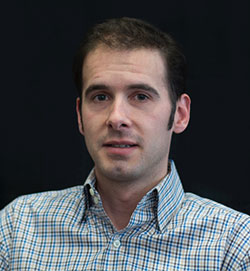
Contact Us
Institutional Communications
Bureau of Mines Building, Room 137
Laramie, WY 82071
Phone: (307) 766-2929
Email: cbaldwin@uwyo.edu

UW Professor Studies Technological Implications of How Judicial System Interprets Video Forensic Analysis
Published September 08, 2021

Justin Piccorelli
In the film “The Secret Life of Walter Mitty,” Sean O’Connell, the photographer character played by Sean Penn, spent the better part of his career trying to snap a photo of the elusive snow leopard in the Himalayas. When the opportunity finally came, O’Connell chose to observe the rare animal through his eyes rather than his lens, saying “If I like a moment, I mean me, personally, sometimes I don’t like to have the distraction of the camera.”
Like that movie character, Justin Piccorelli, an associate professor in the UW School of Politics, Public Affairs & International Studies, took a closer look at how eyewitness and video perspectives differ -- only in the courtroom. Specifically, he analyzed when judicial systems use eyewitness accounts as opposed to video shown and explained by video forensic analysts.
“I was hoping an investigation of the philosophic spectator and forensic video analyst would promote dialogue on the use of video technology and how it shapes our thinking,” Piccorelli says. “Technology is normally developed because it generates profit, but this doesn’t necessarily mean all technologies are good for society. While inventing a technology, it is awfully difficult to understand the ways in which a technology could change our thinking, but I think we can evaluate technology more carefully before readily adopting it. I would like judges, juries, police and citizens to approach video technology with a greater sense of skepticism.”
Piccorelli is the author of a paper, titled “The Judging Spectator and Forensic Video Analysis: Technological Implications for How We Think and Administer Justice,” that was published Aug. 25 in Springer Nature’s journal Philosophy & Technology. The journal addresses the expanding scope and unprecedented impact of technologies to improve the critical understanding of its conceptual nature and practical consequences.
Video technology, like social media technology, is more than just a tool. It implicitly shapes how people experience both space and time, as well as how justice is administered in profound ways, according to the paper.
To investigate this relationship, Piccorelli used his experience during police ride-alongs, which gave him the opportunity to talk with police and compare his own experiences with the video footage he viewed. Based on his own experiences, Piccorelli surmises a spectator with a nontech-mediated view is connected to an event in a different way.
“On these ride-alongs, I was sure certain things happened in person and felt an emotional connection to the actors in an event but, upon review, these details didn’t show up on body camera footage taken at 4K resolution,” he says. “Was what I saw simply my nerves lying to me in a dangerous situation; the result of a camera being taken from a particular angle; or does it point to the limitations of video technology?
“When we watch video footage, or even something like a horror movie, we certainly feel something. This suggests the tech-mediated experience is meaningful to us, but I don’t think it is our inclination to question what we see and unpack the images or emotions that we feel,” Piccorelli adds. “Since the forensic video analyst’s process is rooted in a frame-by-frame dissection and, given their training, it is likely that the analyst believes their interpretation to be objective.”
While the study states that a forensic video analyst’s stance is rooted in objectivity, which appears positive, there also are arguments the video analyst’s presentation may not be conducive to the philosophic spectator, which may rely too much on a video evidence analysis and not critically look at the entire picture of a case as presented.
“To me, the forensic video analyst’s stance initially seemed an awful lot like the philosophic spectator. I had a sense that something was missing from video footage that accounted for my interest, but it was only after unpacking the two that I learned just how different the analyst and the spectator are,” Piccorelli explains. “Video technology has the potential to either enhance or limit our imaginative and reflective abilities. Science fiction movies certainly promote our imaginations in ways research cannot but, if video technology limits our abilities in the justice system, the consequences are severe.”
While Piccorelli says a video analysis expert’s presentation carries weight with a jury, he suggests the analyst has the ability to present his or her findings in a more open way so as to encourage dialogue. For example, Piccorelli says that when he served as a member of a planning commission, the planners’ reports listed “findings of fact.”
“To make an argument against development, the commission had to argue the ‘facts’ were incorrect, which is a really difficult place to begin a discussion from,” he says. “The forensic video analyst is employed to present ‘facts,’ and they might not be rehired if they lack ‘facts.’ But, what if the analyst, instead, presented their ‘interpretation’ or ‘initial findings?’ This could promote dialogue in the courtroom, but the approach would need to be sought out by the entity hiring the analyst.”
Making sense of video technology is further complicated in a modern democracy, which plays a role in technological mediation, according to the research paper. The sheer size of modern democracy means a limited number of people can be physically present to witness an event, suggesting the media and different forms of news agencies might mediate a case a third time.
A recent event where the media weighed in heavily was the George Floyd case in May 2020. The media showed, over and over, the 8.5-minute video of police officer Derek Chauvin pressing his knee on the neck of Floyd, who eventually died. That video shaped public opinion and led to protests and riots across the country.
Later, police body camera footage showed more details of the incident, including Floyd handcuffed in the back of a police car saying he was having trouble breathing and Floyd possibly resisting arrest. Toxicology reports also showed fentanyl in Floyd’s system, which might have affected his breathing. That said, Piccorelli stresses the additional footage of Chauvin’s interaction with Floyd would not have changed the verdict nor public opinion.
“Common sense, something I believe informs the philosophic spectator’s judgment, tells us that holding a knee over Floyd’s neck for eight-and-a-half minutes is not an acceptable reaction even if Floyd resisted arrest,” he says.
Still, Piccorelli expresses caution in relying solely on video footage.
“I think the real danger in using video footage to determine guilt is related to the emotional connection we feel when watching it. This emotion that we feel is real, but it also is fundamentally different from what we might feel if physically present,” he says. “For this reason, I think we tend to forget that we are viewing an event through a narrow lens, from an altogether different space and point in time. Technology tricks us in this way.”
Piccorelli believes citizens, judges, juries and police officers can benefit from this study.
“If we approach video technology with greater skepticism, our justice system should become stronger as a result,” he says. “That said, I could see a change leading to a feeling that the justice system isn’t improving in the short term.”
UW’s Wyoming Institute for Humanities Research (WIHR) offered Piccorelli a semester-long fellowship, which provided him with helpful feedback
and additional time to spend on the paper. For the past six years, Piccorelli has
taught a graduate course, titled “Technology in Public Administration,” and often
presents his ideas to his students. This discussion-based course helps provide Piccorelli
with feedback to strengthen his research.
“For studies like mine that don’t necessarily fit with grant-awarding entities like the National Science Foundation or National Institutes of Health, I’d recommend an entity like WIHR,” he says. “Just because a large grant agency doesn’t have a call that aligns with certain questions doesn’t mean the research isn’t worth doing.”
Contact Us
Institutional Communications
Bureau of Mines Building, Room 137
Laramie, WY 82071
Phone: (307) 766-2929
Email: cbaldwin@uwyo.edu

